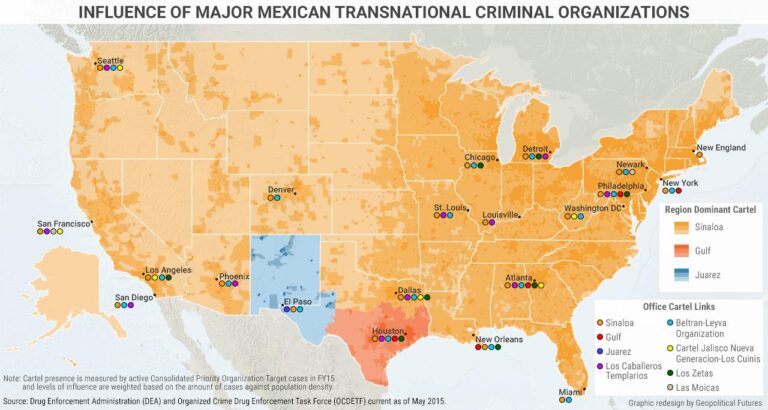The recent analysis from the Brookings Institution challenges the notion that tariffs can effectively curb drug-related crime along the U.S.-Mexico border. As policymakers debate economic measures to address the surge in drug trafficking and violence, experts argue that imposing tariffs fails to tackle the root causes of the crisis. This article delves into Brookings’ findings, shedding light on why trade restrictions alone are unlikely to stem the flow of illicit substances and what alternative strategies may hold promise for both nations.
Tariffs Fail to Address Root Causes of Cross-Border Drug Trafficking
Imposing tariffs on cross-border trade between the U.S. and Mexico has emerged as a popular but ultimately misguided approach to curbing drug trafficking. These tariffs, rather than disrupting criminal networks, primarily affect legitimate economic activities and strain bilateral trade relations. The true catalysts behind drug trafficking lie in complex socio-economic factors, including:
- Widespread poverty and lack of economic opportunities on both sides of the border, which fuel participation in illicit markets as an alternative source of income.
- Weak governance and corruption that allow drug cartels to operate with impunity.
- High domestic demand for illegal drugs in the U.S., incentivizing continuous supply.
In fact, tariffs risk exacerbating these root issues by stifling market growth and reducing employment opportunities in border communities. Solutions that focus on economic development, institutional reforms, and demand reduction strategies are more likely to yield sustainable progress. Below is a comparison that highlights why tariffs miss the mark:
| Aspect | Tariffs | Underlying Solutions |
|---|---|---|
| Effectiveness | Disrupt trade but not criminal networks | Target socio-economic causes of trafficking |
| Impact on economy | Harm legitimate cross-border commerce | Promote job creation and legal earnings |
| Long-term outcome | Temporary setbacks for traffickers | Sustainable reduction in drug flows |
Economic Impact of Tariffs on U.S. and Mexican Communities
Imposing tariffs as a tool to combat drug-related crime overlooks the intricate economic dependencies binding U.S. and Mexican border communities. Both sides rely heavily on cross-border trade, which supports myriad small businesses, agricultural sectors, and manufacturing hubs. Increased tariffs elevate costs for exporters and importers alike, ultimately squeezing local economies that are already vulnerable to crime-driven destabilization. Residents often bear the brunt through reduced employment opportunities and higher consumer prices, magnifying socioeconomic inequalities.
Key economic repercussions include:
- Decreased revenue for family-run enterprises dependent on bilateral trade
- Disruptions to supply chains causing delays and increased operational costs
- Heightened unemployment risks in border municipalities
| Impact Area | U.S. Border Communities | Mexican Border Communities |
|---|---|---|
| Small Business Revenue | -12% decline estimated | -15% decline estimated |
| Unemployment Rates | Upward trend predicted | Significant increase expected |
| Consumer Prices | Rise by 5% in essentials | Rise by 7% in food and fuel |
Holistic Approaches Needed Beyond Trade Restrictions
Addressing cross-border drug crime demands a multifaceted strategy that goes beyond imposing tariffs or trade restrictions. Simply targeting economic exchanges without tackling root causes can lead to unintended consequences, such as disrupting legitimate commerce and exacerbating regional instability. Effective solutions require robust cooperation on intelligence-sharing, community investment, and enhanced law enforcement capabilities that prioritize both borders’ security while respecting human rights.
Key components that must be integrated into a comprehensive approach include:
- Economic development initiatives in border communities to reduce dependence on illicit markets.
- Improved bi-national legal frameworks that streamline extradition and prosecution processes.
- Public health responses addressing addiction issues on both sides of the border.
- Technological innovation in surveillance and drug interdiction efforts that minimize collateral damage.
| Approach | Expected Impact |
|---|---|
| Community Engagement | Lower recruitment into trafficking networks |
| Cross-border Task Forces | Enhanced real-time intelligence exchange |
| Demand Reduction Programs | Decrease in drug consumption rates |
| Legal Reform | Faster case resolutions |
Policy Recommendations for Reducing Drug Crime Through Collaboration
Addressing drug-related violence requires a shift from unilateral economic measures to a multifaceted, coordinated strategy that leverages both U.S. and Mexican resources. Key recommendations include enhancing intelligence sharing and joint law enforcement operations to dismantle trafficking networks effectively. Additionally, bolstering community policing efforts and strengthening border security technology can create a resilient frontline against illicit flows without disrupting legitimate trade.
Crucially, the following collaborative initiatives should be prioritized:
- Establish binational task forces with real-time data sharing protocols
- Invest in social programs targeting at-risk populations in border regions
- Implement synchronized anti-corruption campaigns within judicial and policing bodies
| Recommendation | Expected Impact |
|---|---|
| Binational Task Forces | Faster dismantling of drug rings |
| Community Social Programs | Reduced recruitment by cartels |
| Anti-corruption Campaigns | Enhanced law enforcement integrity |
Future Outlook
As the debate over how best to address the ongoing drug-related violence along the U.S.-Mexico border continues, it is clear that imposing tariffs is not a viable solution. Experts at Brookings emphasize that trade measures alone cannot dismantle the complex networks driving the drug trade or address its root causes. Instead, a comprehensive approach involving cooperation on law enforcement, economic development, and public health initiatives will be essential to making meaningful progress. Policymakers must look beyond tariffs to craft strategies that reduce crime and promote stability on both sides of the border.







